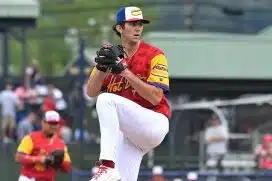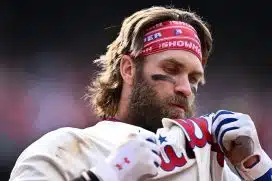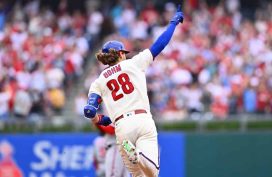By: Jason Ferrie, Sports Talk Philly Columnist
Cesar Hernandez opened his 2017 just as hot as he ended his 2016 campaign. The 26-year-old second-baseman launched a Scott Feldman fastball into the right-field seats at Great American Ballpark Monday. Hernandez is going to need to be a catalyst at the top of the Phillies lineup this season. With Jesmuel Valentin and Scott Kingery looming, 2017 may be the most important season of Hernandez's career.
Last season the Phillies enjoyed watching their second-baseman turn in a 4.4-win season, according to FanGraphs. That was good enough to finish as the ninth-best total for a second-baseman in baseball. The jump from 1.4 WAR to 4.4 WAR is very large and should bring along questions of whether it can be sustained. Hernandez had a very good second half of the season—where he triple-slashed .298/.413/.411 with a 127 wRC+.
The biggest thing to keep an eye on for Hernandez is the large jump in his walk rate between halves. In the first half of 2016, Hernandez drew a walk on just 5.5-percent of the time. For a leadoff hitter, that is less than ideal. In the second half, Hernandez was more patient at the plate, drawing a walk in 15.7-percent of his trips to the plate. That walk rate helped put him into the top-10 at second base. It won’t be easy to sustain those results as Hernandez has never walked over 10-percent of the time in a season. Now there is certainly a reason to be optimistic as Hernandez is entering his second season as a full-time player.
While Hernandez had overall value (4.4-WAR), he does not bring any power to the plate. Among the 21 qualified second-baseman last season, Hernandez had the third lowest slugging percentage at .393. Among that group, Hernandez and Josh Harrison of the Pitsburgh Pirates were the only two not to hit more than 10 home runs. Power isn’t everyone’s game—as we can see with Hernandez, but that seems to be a direct result of his low fly-ball numbers. More often now, you will read about players wanting to hit the ball in the air, as opposed to on the ground because ground balls don’t create runs like fly-balls.
To piggyback on that, Hernandez had a .363 batting average on balls in play (BABIP) last season, which trailed only D.J LeMahieu among second-baseman. The biggest issue with Hernandez is that he is hitting ground balls over 50-percent of the time in each of his four seasons in the majors. Along with that, he isn’t hitting the ball overly hard. Per Baseball Savant, Hernandez's average line drive exit velocity is 91 miles per hour—but when he puts the ball on the ground, which he does half the time, that exit velocity drops to just 85.2 miles per hour. The concern for Hernandez is the higher BABIP and fact that he is putting the ball on the ground in half of his at-bats.
An interesting nugget about Hernandez on offense last season was that he led all second-baseman in bunts for hits with 15. In fact, Hernandez led all of baseball in bunts for hits last season. Per FanGraphs, Hernandez dropped 28 bunts last season and 15 of them turned into hits. That is a rate that will be difficult to sustain this season. The hope for Hernandez in replicating this bunt success is that since 2010, there have been 29 season with 10 or more bunt hits—six players have done it multiple times.
Hernandez enjoyed an improved offensive season, which most noticed right away, but he was also much improved on defense. If we use defensive runs saved (DRS), Hernandez saved four defensive runs in 2016, which was a nine-run improvement in comparison to his -5 DRS in 2015. While the baseball community is still working to better understand defensive metrics and quantify the values, it was a sizeable jump for Hernandez and it even passed the eye test. He will need to keep these numbers in 2017 if he wants to become an asset to the Phillies in the long-term.
The biggest knock on Hernandez, even in a successful 2016 season, was his baserunning. At times during the season, Hernandez appeared to be lost on the base paths. This was a problem during the entire season—where Hernandez stole 17 bases but was caught 13 times. That is a rate that isn’t going to work going forward. It is unclear whether Hernandez had the green light to go when he wanted in 2016, but if that was the case, that right needs to be pulled back until he can steal bases with a higher rate of success. It will be interesting to see what the Phillies do as they will probably have issues generating offense, which leads me to believe Pete Mackanin will want to run to get guys in scoring position. The reason to be a little optimistic about Hernandez improving is that the Phillies were caught stealing as a team at the lowest rate in baseball. Part of that is getting runners on base—which is what the Phillies struggle to do.
There are a few reasons to be optimistic about Hernandez early in 2017. He is in the midst of his second full season, which could lead to more adjustments at the plate, perhaps more like what he showed in the second half of 2016. While a 15-percent walk-rate is highly unlikely, he could reach his first 10-percent walk-rate. On the defensive end, Hernandez was much improved, according to the advanced metrics. This is something that we need to look at throughout the season as Hernandez has not been a great defender throughout his young career. On the basepaths, Hernandez will most likely be a nightmare, but hopefully the Phillies address his stolen base issues.
Overall, I am not going to buy Hernandez as a 4-win player because of a few things that I am not buying. First, he hit 11 triples last season, which I will bet against. The second-half walk-rate is something I don’t believe is sustainable for a player who averaged 7-to-8-percent prior to last season. The bunt hits are another category I would be against as Hernandez isn’t classified as a speed demon, and I have a bias against bunts so I’d prefer to see him swing the bat. Speaking of swinging the bat, Hernandez putting the ball on the ground over half the time isn’t an ideal situation, in my opinion. While I do think he is a decent player, I would say he is closer to a 2-win player rather than a 4-win player. This would make him a very good stop-gap if the Phillies believe Scott Kingery or another prospect is the future or a potential trade chip come the deadline.







